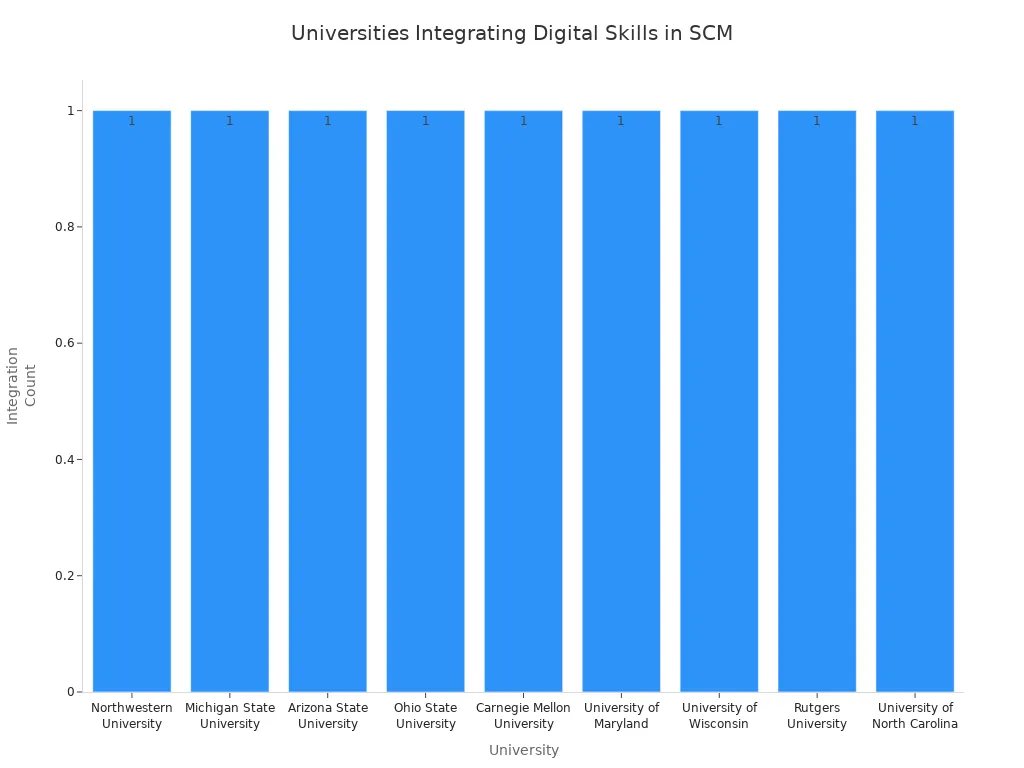Supply Chain Management Programs Digital Makeover

Supply chain management faces rapid change as organizations demand professionals who master digital tools and analytics. Many leading programs now prioritize hands-on learning and technical skills. Nearly 74% of executive education courses focus on digital transformation, while 63% include data analytics for business problem-solving. Universities such as Northwestern, Michigan State, and Arizona State have adopted digital-first approaches. This digital makeover strengthens management education and boosts graduate readiness for complex supply chain management challenges.

Key Takeaways
Supply chain management programs now use digital tools like AI, data analytics, and automation to prepare students for modern challenges.
Hands-on learning and simulations help students apply digital skills in real-world supply chain scenarios.
Employers seek professionals with strong digital skills to improve decision-making, efficiency, and resilience in supply chains.
Digital technologies enable companies to predict problems, optimize inventory, and respond faster to market changes.
Successful digital transformation requires careful planning, staff training, and adapting legacy systems to new technologies.
Digital Makeover in Supply Chain Management

What Is a Digital Makeover?
A digital makeover in supply chain management programs means transforming traditional processes with digital technologies. Universities and executive education institutions now use a digital approach to modernize how they teach and manage supply chains. The Rutgers Mini-MBA: Digital Supply Chain Management program shows this shift by mapping process ecosystems and using digital solutions to improve efficiency and resilience. These programs help organizations predict and prevent disruptions. They also enhance roles in logistics, procurement, and inventory management with modern tools.
A digital makeover covers more than just technology upgrades. It includes a holistic strategy that integrates and analyzes data from every part of the supply chain. This approach helps organizations create value, improve customer experience, and increase revenue. Programs now teach students how to manage globalization, build resilient organizations, and support green initiatives. The digital approach prepares graduates to handle complex supply chain management challenges in a fast-changing world.
A digital makeover in supply chain management education means using new technologies and data analytics to make supply chains smarter, faster, and more flexible.
Core Technologies in Education
Modern supply chain management programs rely on a range of emerging technologies. Artificial intelligence forms the backbone of many new courses, giving students both foundational knowledge and practical skills. AI helps students understand how to automate decisions and optimize supply chain operations. Data analytics and predictive analytics play a key role in real-time decision-making. Students learn to use data to spot trends, forecast demand, and solve problems before they grow.
Many universities now teach enterprise resource planning (ERP) systems. These systems help students manage inventory, production schedules, and partner collaboration. Automation and robotics are also part of the curriculum. For example, the Omron Advanced Automation Lab at Marquette University lets students work with real robots and automation tools. Warehouse management systems give students hands-on experience with inventory and logistics management.
Hands-on simulations have become a standard feature in these programs. The University of Tennessee uses a simulated microbrewery to help students understand supply chain complexity. These simulations let students apply digital skills in realistic scenarios. Universities like Iowa State, Marquette, Tennessee, and Wisconsin have adopted these technologies to meet industry demand for tech-savvy professionals.
Key technologies in supply chain management education:
AI and machine learning
Data analytics and predictive analytics
ERP systems
Automation and robotics
Warehouse management systems
Hands-on simulation tools
This digital approach ensures that graduates leave with the skills needed to thrive in a world shaped by technology and data. Programs now focus on building digital skills, using analytics, and applying technology to real-world problems. The digital makeover in supply chain management education prepares students for the future of global supply chains.
Evolving Supply Chain Management Programs
Curriculum Overhauls
Universities and executive education providers have transformed the supply chain management curriculum to address the demands of modern supply chains. Since 2020, programs have added new modules that focus on digital and advanced analytics applications. These changes help students build data literacy, algorithmic understanding, and integrated decision-making skills. The curriculum now covers a broad range of topics, moving beyond traditional management to include AI, automation, and data analytics.
New modules teach students how to use AI for supply chain optimization.
Courses in data analytics help students interpret large datasets and make informed decisions.
Simulations and hands-on projects allow learners to apply digital tools in real-world scenarios.
Digital strategy courses prepare students to lead transformation efforts in global supply chains.
Leadership training targets senior and midlevel professionals, ensuring they can drive digital change.
A table below highlights recent additions to supply chain management programs:
Course Name | Provider | Focus Areas |
|---|---|---|
ELVTR | AI, automation, predictive modeling | |
Supply Chain Management: Leading with AI and Digital Transformation | MIT xPRO | Analytics, machine learning, digital twins |
Wharton Executive Education | AI, customer analytics, digital strategy |
Digital Skills for Professionals
Employers now seek supply chain management professionals with strong digital skills. AI, data analytics, and software engineering top the list of technical abilities in demand. Digital literacy, including cloud computing and digital workplace systems, is essential. Professionals must also demonstrate problem-solving, communication, and collaboration skills within digital environments.
AI and data analytics skills are critical for managing global supply chains.
Digital content creation and information visualization support better decision-making.
Adaptability and creative thinking with digital tools provide a competitive edge.
Upskilling in AI and analytics helps bridge the talent gap in supply chain management.
Programs now prepare graduates to lead digital transformation in global supply chains. They emphasize innovation, resilience, and strategic risk management. Practical experiences, such as simulations and capstone projects, ensure students can apply theory to real-world challenges.
Improve Supply Chain Resilience

Data-Driven Decision Making
Digital transformation gives organizations the power to improve supply chain resilience. By using advanced data diagnostics, companies can analyze large amounts of information to spot patterns and find problems early. This approach helps leaders make faster and more accurate decisions. Demand sensing uses predictive analytics and artificial intelligence to forecast changes in the market. Companies can then adjust their inventory before issues arise. Inventory optimization uses AI-driven analytics to lower costs and prevent stockouts. These tools help modern supply chains stay efficient and flexible.
Data diagnostics and AI analyze vast datasets to identify patterns and anomalies, enabling faster, more accurate decision-making.
Demand sensing improves forecasting by anticipating market changes, allowing organizations to adjust inventory proactively.
Inventory optimization uses AI-driven analytics to minimize costs and prevent stockouts, enhancing supply chain efficiency.
IoT devices provide real-time tracking and condition monitoring, supporting timely interventions and transparency.
These technologies collectively enhance supply chain agility, risk mitigation, and operational resilience in digitally transformed organizations.
Education programs now teach students how to use these digital tools. Learners practice with real-time data and simulations. They learn how to hedge supply chain risks and keep operations running smoothly. This training prepares future professionals to handle disruptions and keep logistics moving.
Enhancing Visibility and Efficiency
Digital technologies have changed how companies see and manage their supply chains. Artificial intelligence and real-time data tracking give leaders a clear view of every step in the process. This visibility helps them spot problems quickly and fix them before they grow. Gen AI and automation improve forecasting accuracy and make complex data easy to understand. These advances help companies respond faster to market changes and customer needs.
Improvement Metric | Reported Improvement | Impact / Example |
|---|---|---|
Reduction in recovery times | Enables smoother, more resilient supply chain operations | |
Reduction in out-of-stock scenarios | 25% | Leads to more reliable product availability and higher customer satisfaction |
Reduction in lead times | 20% | Streamlines warehouse operations and speeds delivery |
Transportation costs | Lowered | Coca-Cola’s real-time yard tracking reduced transportation costs and improved freight movement |
Inventory management | Optimized stock levels, reduced carrying costs | Frees working capital and reduces excess safety stock through AI-powered forecasting |
Order accuracy, delivery times, inventory turnover, customer satisfaction | Improved | Enhanced by real-time tracking and AI-driven analytics |
Integration of systems (TMS, WMS, ERP) | Enabled seamless data sharing | Reduces errors and improves decision-making |
Forecasting accuracy | Enhanced by Gen AI and automation | Improves pattern recognition and operational efficiency |
Operational efficiency and responsiveness | Improved | Demonstrated by companies like XYZ Corp, 3M, Hormel, and ABC Ltd through technology adoption |
Modern supply chains benefit from unified planning and execution. Companies use digital platforms to connect logistics, distribution, and transportation systems. This approach breaks down silos and maximizes efficiency. Real-time data and automation reduce manual work and improve productivity. Predictive analytics and scenario planning help organizations anticipate disruptions and act quickly. These changes improve customer satisfaction and make supply chains more reliable.
Note: Real-time visibility and data-driven decision-making reduce costs, improve customer satisfaction, and enable demand sensing. Advanced technologies like IoT, AI, and cloud computing provide continuous tracking and forecasting, enhancing operational responsiveness.
Organizations that embrace digital transformation can hedge supply chain risks and respond to challenges with greater agility. They gain the ability to adapt quickly, keep products moving, and maintain strong logistics networks even during disruptions.
Overcoming Digital Transformation Challenges
Integrating Legacy Systems
Many organizations face challenges when they try to digitize logistics and supply chain management. Legacy systems often create barriers. These older systems may not work well with new technology. They can cause problems like security risks and limited data analytics. Companies often solve these issues by using cloud-based solutions. Cloud platforms offer APIs that help connect old and new systems without expensive custom coding. Modern ERP systems also help by removing data silos and making information easier to use.
A smart approach starts with simple, high-impact projects. For example, moving email servers to the cloud can build confidence for bigger changes. Many organizations work with managed service providers who have experience in system integration. These experts plan the migration and make sure business operations continue smoothly. They also focus on master data management and end-to-end supply chain processes. This strategy helps connect all business functions and reduces disruption.
Tip: Start digital transformation with less complex projects to build momentum and reduce risk.
Addressing Security and Change
Digital transformation brings new data security concerns. Organizations must protect sensitive information as they upgrade systems and adopt new technology. Common risks include unauthorized access, data breaches, and cyberattacks. Companies use several methods to keep data safe:
Security Measure | Description |
|---|---|
Vulnerability Testing | Regular scans and tests to find and fix weak points in systems |
Protects sensitive data during storage and transfer | |
Access Control | Limits who can see or change important information |
Prepares teams to act quickly if a breach happens | |
Third-Party Risk Management | Checks that suppliers and partners follow strong security standards |
Workforce adaptation is another challenge. Employees may resist new systems or lack digital skills. Clear communication and early engagement help reduce fear and build trust. Training programs teach staff how to use new technology. Leaders should support a culture that welcomes change and rewards innovation. A structured change management process includes preparing, planning, implementing, and monitoring progress. Recognizing and celebrating small wins keeps teams motivated.
Note: Continuous education and strong leadership help organizations adapt to new technology and keep supply chains secure.
Steps for a Successful Digital Makeover
Assess and Plan
A successful digital makeover begins with a thorough assessment. Organizations and educational institutions evaluate readiness across people, processes, and technology. Leaders review culture, infrastructure, and human resources to understand if teams feel prepared for change. Many use maturity models like the Smart Industry Readiness Index or RAMI 4.0 to guide this process. These frameworks help identify strengths and gaps. Management must show strong support and provide resources for the digital approach to succeed. Teams then create a clear roadmap that outlines goals, timelines, and key milestones. This plan covers the entire value chain, ensuring no area gets overlooked.
Tip: Regularly revisit the roadmap to adjust for new challenges and opportunities.
Implement and Train
Implementation starts with selecting the right digital technologies. Decision-makers consider organizational needs, technology fit, and innovation potential. They use models like DIKW (Data, Information, Knowledge, Wisdom) to support choices. Teams automate repetitive tasks and use digital platforms to connect suppliers and partners. Real-time data becomes central for accurate decisions. Training plays a key role. Staff learn to use new tools, and leaders foster a culture that values digital skills. Ongoing training ensures everyone stays up to date with the latest advancements, including AI and automation.
A sample implementation checklist:
Step | Action Item |
|---|---|
Technology Selection | Match tools to business needs |
Data Readiness | Ensure data is accessible and secure |
Staff Training | Provide digital skills workshops |
Process Optimization | Streamline workflows for efficiency |
Monitor and Adapt
Continuous improvement drives long-term success. Organizations use software like ERP and SCM systems to track performance. They monitor key metrics such as on-time delivery and inventory turnover. AI and analytics help spot risks and predict disruptions. Teams use scenario planning to prepare for changes in demand or supply. Regular reviews of the digital supply chain roadmap keep strategies aligned with business goals. Cross-functional collaboration ensures all departments work together. By embracing a digital approach, organizations stay agile and ready for future challenges.
Note: Continuous monitoring and adaptation help organizations remain resilient and competitive in a fast-changing world.
Real-World Success Stories
University Program Innovations
West Virginia University stands out for its innovative approach to supply chain management education. The Wehrle Global Supply Chain Lab uses virtual reality to create immersive simulations. Students practice real-world supply chain operations in a digital environment. Faculty leadership and donor support make this possible. This hands-on experience with advanced digital tools helps students build practical skills and prepares them for modern industry challenges.
The University of Wisconsin-Milwaukee’s Lubar College of Business offers a unique MS in Digital Supply Chain Management. This program integrates Industry 4.0 technologies, including IoT, machine learning, blockchain, digital twins, and cloud architecture. The Connected Systems Institute and SAP University Competence Center support this program. Students learn to use the latest digital tools, making them ready for the demands of today’s supply chain management roles.
These university programs show how digital transformation can boost graduate readiness and set new standards for supply chain management education.
Industry Case Studies
Many industries have seen major improvements after digital makeovers. The aerospace and defense sector faced big disruptions after the pandemic. Companies in this field now use agile supply chains and smart factory solutions. These changes improve visibility, foster innovation, and strengthen relationships with partners. Industrial manufacturers also use advanced technologies and supplier diversification to build resilience and keep costs down.
Industry Sector | Transformation Approach | Key Initiatives & Technologies | Outcomes & Impact |
|---|---|---|---|
Life Sciences | Enterprise-wide platform transformation (EPT) | New sourcing platform, spend analytics, supply chain control tower, sales & operations planning | ~$250M savings; improved procurement efficiency; enhanced risk mitigation; optimized inventory & logistics costs |
Metals Producer | EPT with cloud-based advanced planning system | Digital use cases across value chain, capability building, change management | EBITDA increase 2-5%; 8-10% carbon emission reduction; OTIF delivery improved 5-10%; inventory reduced 9-10% |
Consumer Packaged Goods (CPG) | EPT with focus on cross-functional initiatives | Procurement optimization, sales network simplification, manufacturing automation, digital supply chain platform | EBITDA uplift ~25%; cost savings in procurement, manufacturing, logistics; improved sales efficiency and revenue growth |
Companies measure the impact of digital transformation using real-time platforms. These tools help reduce lead times, cut costs, and improve customer satisfaction. Studies show that organizations with mature digital supply chain management report higher revenue growth and better customer engagement. These results prove that digital makeovers drive both operational and financial success.
Digital makeovers have reshaped supply chain management by introducing AI, blockchain, and advanced analytics. These changes address delays, errors, and inventory shortages, making supply chains smarter and more reliable.
Educational programs now teach digital skills like data science and analytics.
Organizations can assess digital readiness by reviewing leadership, policies, training, and infrastructure.
Unify data and automate processes.
Train teams on new technologies.
Future-ready supply chains depend on continuous innovation and proactive digital adoption.
FAQ
What is a digital makeover in supply chain management education?
A digital makeover updates supply chain programs with new technologies. Schools add courses on AI, analytics, and automation. Students learn to use digital tools for real-world supply chain problems.
Why do companies want graduates with digital supply chain skills?
Companies need workers who can use data and technology. Digital skills help teams solve problems faster and make better decisions. Employers value graduates who understand AI, analytics, and automation.
How do hands-on simulations help students?
Hands-on simulations let students practice real supply chain tasks. They use digital tools in safe, controlled settings. This experience builds confidence and prepares students for jobs in the field.
What challenges do organizations face during digital transformation?
Organizations often struggle with old systems, security risks, and staff training. Leaders must plan carefully, protect data, and help employees learn new skills.
Can digital supply chain programs improve job opportunities?
Yes. Digital supply chain programs teach skills that employers want. Graduates often find more job options and higher salaries because they know how to use the latest technology.
See Also
How Cloud Technologies Are Transforming Supply Chain Operations
Digital Innovations Paving The Way For Future Logistics
Unlocking Supply Chain Efficiency Through Logistics Cost Savings
Will Digital Twin Technology Revolutionize Supply Chain Optimization
Cloud-Based Supply Chain Tools Driving Industry Transformation
